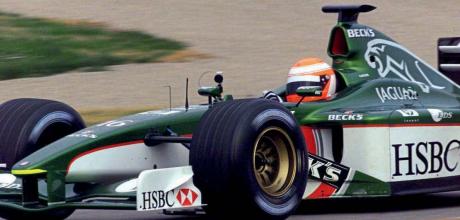Niki Lauda tests the Jaguar R2, Valencia, January 2002
With no world championships or even victories to its name, Jaguar Racing’s four years in Formula 1 were a big disappointment. But it did, albeit briefly, have a three-time champion drive one of its cars.
FINISHING LINES
Halfway through the 2001 season, Niki Lauda – who had won the 1975, 1977 and 1984 World Championships – replaced Bobby Rahal as Jaguar Racing’s team principal. Not only did parent company Ford hope the Austrian would turn the struggling team around but his appointment allowed for a unique publicity stunt. In mid-January 2002, the then 51-year-old tested the previous year’s Cosworth-engined R2 at Valencia in Spain, the first time he’d driven an F1 car since he’d retired in 1985.
Yet Lauda reckoned this was more than just to create newspaper column inches. “My intention was to learn as much about the electronic systems on the car as possible, so that I can relate directly to the drivers’ experiences when they are describing technical computer-related issues,” he said to the assembled press afterwards. “Today, I have finally discovered what they experience and how I can better assist them in my capacity as team boss.”
Lauda soon showed he’d lost none of his skill behind the wheel. With 50kg of fuel on board, he was as quick in a straight line as Jaguar Racing’s driver, Pedro de la Rosa, and his entry speed into two of the circuit’s corners was identical to the Spaniard’s, despite spinning at the same bend on consecutive laps.
“I span because I was braking where Pedro had told me to brake!” Lauda later joked, “But I was pleased that I went into the corner at the same speed as him until it spun. I would much rather have spun today than be accused by Pedro and Eddie [Irvine] of having tiptoed around the circuit.”
Yet due to the electronic traction control, Lauda found the Jaguar R2’s handling more progressive than the F1 cars he was used to. “Admittedly today’s cold tyres did not help but I would say overall grip levels are lower than with the full slicks I remember. This is due to grooved tyres and less aerodynamic pressure on a modern F1 car,” he recalled.
“When I raced, it was left to the driver to fully control the car. These electronic advances in Formula 1 now make the sport the technology leader in the auto industry. After all, traction control technology and other computer-driven systems, in different forms, are now available on many road cars, including Jaguars.”
Despite his fast times, Lauda had no plans for a full-time return, saying afterwards, “I did no physical preparation for this test – apart from reduce smoking!” The ten laps in the Jaguar R2 were the last time he would drive a Formula 1 car.
With 2002 being another torrid season for the Milton Keynes-based outfit with only one podium – a third for Irvine at Monza in September – which saw it finish a paltry seventh in the Constructors’ Championship, Lauda was clearly better in the cockpit than out of it. He was asked to stand down as team principal at the end of the year.


